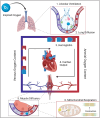Skeletal Muscle Pathology in Pulmonary Arterial Hypertension and Its Contribution to Exercise Intolerance
- PMID: 39921526
- PMCID: PMC12074786
- DOI: 10.1161/JAHA.124.036952
Skeletal Muscle Pathology in Pulmonary Arterial Hypertension and Its Contribution to Exercise Intolerance
Abstract
Pulmonary arterial hypertension is a disease of the pulmonary vasculature, resulting in elevated pressure in the pulmonary arteries and disrupting the physiological coordination between the right heart and the pulmonary circulation. Exercise intolerance is one of the primary symptons of pulmonary arterial hypertension, significantly impacting the quality of life. The pathophysiology of exercise intolerance in pulmonary arterial hypertension is complex and likely multifactorial. Although the significance of right ventricle impairment and perfusion/ventilation mismatch is widely acknowledged, recent studies suggest pathophysiology of the skeletal muscle contributes to reduced exercise capacity in pulmonary arterial hypertension, a concept explored herein.
Keywords: exercise intolerance; mitochondrial dysfunction; oxygen pathway; pulmonary hypertension; skeletal muscle dysfunction.
Conflict of interest statement
None.
Figures




References
-
- McLaughlin VV, Shillington A, Rich S. Survival in primary pulmonary hypertension. Circulation. 2002;106:1477–1482. - PubMed
Publication types
MeSH terms
Grants and funding
LinkOut - more resources
Full Text Sources
Medical

